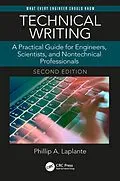Technical Writing: A Practical Guide for Engineers, Scientists, and Nontechnical Professionals, Second Edition enables readers to write, edit, and publish materials of a technical nature, including books, articles, reports, and electronic media. Written by a renowned engineer and widely published technical author, this guide complements traditional writer's reference manuals on technical writing through presentation of first-hand examples that help readers understand practical considerations in writing and producing technical content. These examples illustrate how a publication originates as well as various challenges and solutions.
The second edition contains new material in every chapter including new topics, additional examples, insights, tips and tricks, new vignettes and more exercises. Appendices have been added for writing checklists and writing samples. The references and glossary have been updated and expanded. In addition, a focus on writing for the nontechnical persons working in the technology world and the nonnative English speaker has been incorporated. Written in an informal, conversational style, unlike traditional college writing texts, the book also contains many interesting vignettes and personal stories to add interest to otherwise stodgy lessons.
Autorentext
Dr. Phil Laplante is Professor of Software and Systems Engineering at The Pennsylvania State University. He received his B.S., M.Eng., and Ph.D. from Stevens Institute of Technology and an MBA from the University of Colorado. He is a Fellow of the IEEE and SPIE and has won international awards for his teaching, research and service. Since 2010 he has led the effort to develop a national licensing exam for software engineers.
He has worked in avionics, CAD, and software testing systems and he has published more than 33 books and 250 scholarly papers. He is a licensed professional engineer in the Commonwealth of Pennsylvania. He is also a frequent technology advisor to senior executives, investors, entrepreneurs and attorneys and actively serves on corporate technology advisory boards.
His research interests are in software testing, requirements engineering and software quality and management. Prior to his appointment at Penn State he was a software development professional, technology executive, college president and entrepreneur.
Klappentext
Engineers, scientists, and professionals of all types are often required to write reports, summaries, manuals, and guides. While many have had an English language or writing course, it is less likely that they have had instruction in the special requirements of technical writing. Filling this void, Technical Writing: A Practical Guide for Engineers, Scientists, and Nontechnical Professionals, Second Edition enables readers to write, edit, and publish materials of a technical nature, including books, articles, reports, and electronic media. Written by a renowned engineer and widely published technical author, this guide complements traditional writer's reference manuals on technical writing through presentation of first-hand examples that help readers understand practical considerations in writing and producing technical content. These examples illustrate how a publication originates as well as various challenges and solutions.The second edition contains new material in every chapter including new topics, additional examples, insights, tips and tricks, new vignettes and more exercises. Appendices have been added for writing checklists and writing samples. The references and glossary have been updated and expanded.a In addition, a focus on writing for the nontechnical persons working in the technology world and the nonnative English speaker has been incorporated. Written in an informal, conversational style, unlike traditional college writing texts, the book also contains many interesting vignettes and personal storiesa to add interest toa otherwise stodgy lessons.a Key FeaturesOffers precise, hands-on coverage of technical writingComplements traditional writer's reference manualsIncludes personal anecdotes and historical stories that serve as real-world examples of technical writingExplores the various avenues for publishing your workExplains how to write for blogs, social networks, and other e-media
Inhalt
Chapter 1: The Nature of Technical Writing 1.1 Introduction 1.2 Who Writes Technical Documentation? 1.3 Taxonomy of Technical Writing 1.4 Technical Reporting 1.5 Business Communications 1.6 Scientific Writing 1.7 Exercises 1.8 References
Chapter 2: Technical Writing Basics 2.1 Introduction 2.2 Structuring Your Writing 2.3 Positioning Your Writing 2.4 Choosing the Right Words 2.5 Avoiding Traps 2.6 Making Your Technical Writing More Interesting 2.7 The 5 Cs of Technical Writing 2.8 Referencing 2.9 Exercises 2.10 References
Chapter 3: The Writing Process 3.1 Introduction 3.2 The Traditional Writing Process 3.3 Environment 3.4 Dealing with Writer's Block 3.5 Meeting Deadlines 3.6 Writing Tools 3.7 Permissions and Plagiarism 3.8 Making Your Writing Understandable to All 3.9 Exercises 3.10 References
Chapter 4: Scientific Writing 4.1 Introduction 4.2 Technical Reports 4.3 Tutorials 4.4 Opinion 4.5 Research Papers 4.6 Reviews of books, papers, and reports 4.7. Exercises 4.8 References
Chapter 5: Business Communications 5.1 Introduction 5.2 Resumes 5.3 Transmittal Letters 5.4 Writing letters of reference 5.5 Memos 5.6 Meetings, Agendas and Minutes 5.7 Customer Relations Writing 5.8 Press Releases 5.9 Presentations 5.10 Marketing and sales materials 5.11 Exercises 5.12 References
Chapter 6: Technical Reporting 6.1 Introduction 6.2 Technical Procedures 6.3 Proposals 6.4 Panel Sessions 6.5 Strategic Plans and Planning 6.6 Problem Reports 6.7 User Manuals 6.8 Exercises 6.9 References
Chapter 7: Using Graphical Elements 7.1 Breaking up the Monotony 7.2 Modeling Ideas with Graphics 7.3 Selecting the best model for a schedule 7.4 Dealing with Figures 7.5 Dealing with Tables 7.6 Dealing with equations 7.7 Dealing with Dynamic Content 7.8 Exercises 7.7 References
Chapter 8: Publishing Your Work 8.1 Introduction 8.2 Making a living as a writer 8.3 The Review Process 8.4 Handling Rejection 8.5 Open Access Publishing 8.6 Self-publishing 8.7 Exercises 8.8 References
Chapter 9: Writing For E-Media 9.1 Introduction 9.2 Email can be Dangerous 9.3 E-newsletters 9.4 Blogging 9.5 Social Networks 9.5 E-Magazines 9.7 E-Readers 9.8 Online Courses 9.9 Exercises 9.9 References
Chapter 10: Writing with Collaborators 10.1 Introduction 10.2 Writing in Different Voices 10.3 Very Large Collaborative Writing Projects 10.4 Behavior of Groups 10.5 Other Paradigms for Team Building 10.6 Antipatterns in Organizations 10.7 Exercises 10.8 References
Appendix A: Writing Checklist Appendix B: Writing Samples
Glossary
